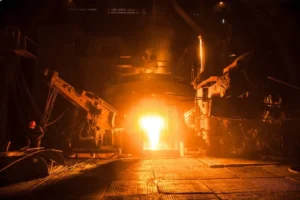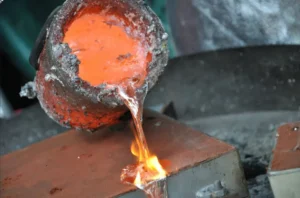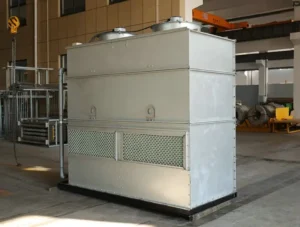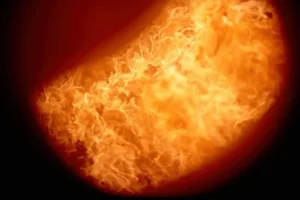Mga hurno ng induction, as an advanced heating technology, play a pivotal role in achieving sustainable development goals.
They contribute significantly to building a greener, more efficient industrial production system by reducing carbon emissions, improving resource utilization efficiency, at promoting a circular economy.
Reducing Carbon Emissions
Induction furnaces contribute to reducing carbon emissions in several ways.
- High Energy Efficiency and Low Energy Consumption: The principle of induction heating involves directly generating heat within the workpiece through electromagnetic induction, rather than transferring heat via an external medium. This direct heating method significantly reduces heat loss, leading to a substantial improvement in energy utilization efficiency. Compared to traditional coal or gas-fired furnaces, induction furnaces can achieve energy efficiencies of an impressive 60% sa 80%, far surpassing the 30%-50% or even lower efficiency of traditional resistance furnaces. Higher energy efficiency means less total energy is required to complete the same heating task, directly reducing carbon emissions from energy production.
- Clean Energy Option: Induction furnaces use electricity as their energy source, and electricity can be generated from various clean energy sources (such as solar, wind, and hydropower). As global investment in and utilization of renewable energy continue to increase, induction furnaces can integrate better with these clean energy sources, further lowering their operational carbon footprint. When the electricity source is renewable, the carbon emissions from induction furnaces are virtually zero.
- Precise Temperature Control, Reduced Overheating: Induction furnaces allow for precise control at rapid response to heating temperatures. This means that heating temperatures can be accurately set according to production needs, avoiding unnecessary overheating and thus saving energy. Halimbawa, in metal heat treatment processes, traditional furnaces might require longer preheating times and incur higher heat losses, whereas induction furnaces can reach the desired temperature almost instantly, significantly shortening heating time and reducing energy consumption.
- No Combustion, No Exhaust Gas Emissions: Unlike coal or gas-fired furnaces, induction furnaces do not produce any combustion exhaust gases, such as carbon dioxide, sulfur dioxide, or nitrogen oxides, during the heating process. This not only helps reduce greenhouse gas emissions but also prevents the generation of air pollutants, which is crucial for improving atmospheric quality.
Improving Resource Utilization Efficiency
Induction furnaces enhance resource utilization through the following methods.
- Higher Material Yield: In metal melting and casting processes, the precise temperature control and uniform heating characteristics of induction furnaces effectively reduce metal oxidation losses and the volatilization of alloying elements. For instance, when melting steel, traditional furnaces might have a burn-off rate of over 5%, while induction furnaces can control this rate to less than 1%, significantly increasing the metal yield and reducing raw material waste.
- Reduced Scrap Rate: Precise temperature control and heating uniformity enable induction furnaces to better control product quality. In applications like heat treatment and forging, the scrap rate caused by uneven heating or temperature deviations is significantly reduced. Halimbawa, in the quenching of automotive components, induction quenching ensures the uniformity and depth of the hardened layer, reducing the number of parts scrapped due to quality issues.
- Extended Mold and Tool Lifespan: In processes like forging and die-casting, induction heating provides a more uniform and controllable heating process, which helps reduce the thermal stress on molds and tools. Compared to traditional furnaces, induction heating can extend the lifespan of molds and tools by 10% sa 30%, thereby reducing the need for new molds and tools during production and conserving resources.
Promoting a Circular Economy
Induction furnaces contribute to promoting a circular economy primarily through.
- Efficient Recycling of Metal Scraps: Induction furnaces are ideal equipment for recycling and reusing scrap metal. They can efficiently melt various types of scrap steel, cast iron, and aluminum, transforming them into high-quality recycled metal for the production of new products. Due to their fast heating speed and high melting efficiency, induction furnaces are widely used in the scrap metal recycling industry, providing vital technical support for the circular utilization of metal resources. In the steel industry, halimbawa na lang, melting scrap steel into new steel using induction furnaces can significantly reduce the need for mining virgin resources like iron ore, lowering resource consumption and environmental impact.
- Facilitating Material Regeneration: Beyond metals, induction heating technology is also applied to the regeneration of other materials, such as plastic recycling and reprocessing. Through induction heating, precise melting and shaping of recycled plastics can be achieved, allowing them to regain their utility, thereby reducing plastic waste generation and promoting the plastic circular economy.
- Reducing Waste Generation: As mentioned above, by improving material yield and reducing the scrap rate, induction furnaces directly reduce waste generated during production. Furthermore, due to their non-combustion nature, induction furnaces themselves do not produce solid industrial waste, further lessening the environmental burden.
- Extending Product Lifespan: Through induction heat treatment technology, the strength, tigas na tigas, and wear resistance of metal components can be significantly improved, thereby extending the product’s service life. Halimbawa, automotive crankshafts and gears treated with induction quenching exhibit greatly enhanced durability, reducing the frequency of component replacement and consequently the need for new product manufacturing and waste generation. This aligns perfectly with the “extending product lifespan” concept within the circular economy.
Mga hurno ng induction, with their efficient, malinis na, and precise characteristics, demonstrate significant advantages in reducing carbon emissions, improving resource utilization efficiency, and promoting a circular economy.
They are not only crucial technological supports for the industrial transition towards sustainable development but also contribute significantly to achieving global climate goals and building a resource-saving society.







